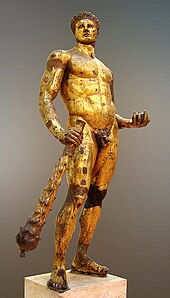User:Melisa103/sandbox
Evaluating articles
The Anatomy Lesson of Dr. Nicolaes Tulp by Rembrandt is the article that I choose. Over viewing the article I think it can be work on a little more, it does have the enough information about the painting and the background, but they didn't talk much about any painting technique, Maybe a good change would be to replace the topic of Popular Culture with the painting technique. Throughout the article it has a neutral tone while reading it, a straight forward article about the painting. This article received a C-rating for the visual art and for the medicine, but for the medicine focus it got a low C-rating. And while looking at the talk page it's mostly about the medicine than the art aspect .
 | This is a user sandbox of Melisa103. You can use it for testing or practicing edits. This is not the sandbox where you should draft your assigned article for a dashboard.wikiedu.org course. To find the right sandbox for your assignment, visit your Dashboard course page and follow the Sandbox Draft link for your assigned article in the My Articles section. |
 | This is a user sandbox of Melisa103. You can use it for testing or practicing edits. This is not the sandbox where you should draft your assigned article for a dashboard.wikiedu.org course. To find the right sandbox for your assignment, visit your Dashboard course page and follow the Sandbox Draft link for your assigned article in the My Articles section. |
Final Article
Hercules of the Forum Boarium is one of two gilded bronze statues found on the site of the
Description

The bronze sculpture is slightly over life-sized
Subject
The statue of Hercules from Forum Boarium is based on his twelve labors where he must bring back the Golden Apples of Hesperides to Eurystheus. Hercules found Prometheus during his search and freed him from his prison. In return, Prometheus told him where he can find the Golden Apples. The apples were guarded by a hundred-headed dragon named Ladon who could not be conquered by Hercules. In order to defeat Ladon, he needed the help of Atlas, the titan that held up the Earth and Heavens on his shoulder. Hercules managed to convince Atlas to help him get the apples, but in exchange, Hercules would have to carry the weight of the world while Atlas acquired the apples. When Atlas returned with the apples, he did not want to retake the weight of the world back. Hercules tricked Atlas by saying that he would gladly stay and hold up the world, but asked Atlas if he could take the weight again so he can adjust his cloak. Atlas took back the weight of the world and Hercules immediately picked up the Golden Apples and ran off [4].

History
The temple of the Forum Boarium in Rome is located by the
Notes
- ^ Height 2.41 m.
- ^ OLGA, PALAGIA,. "TWO STATUES OF HERCULES IN THE FORUM BOARIUM IN ROME". Oxford Journal of Archaeology.
{{cite web}}: CS1 maint: extra punctuation (link) CS1 maint: multiple names: authors list (link) - ^ OLGA, PALAGIA,. "TWO STATUES OF HERCULES IN THE FORUM BOARIUM IN ROME". Oxford Journal of Archaeology.
{{cite web}}: CS1 maint: extra punctuation (link) CS1 maint: multiple names: authors list (link) - ^ Symmachus, Aurelius. "The Temple of Hercules". www.roman-empire.net.
- ^ Eugène Müntz, Les arts à la cour des papes pendant le XVe et le XVIe siècle, vol. III:177f.
- ^ inv. no. MC1265; Haskell and Penny 1981:227
- ^ OLGA, PALAGIA,. "TWO STATUES OF HERCULES IN THE FORUM BOARIUM IN ROME". Oxford Journal of Archaeology.
{{cite web}}: CS1 maint: extra punctuation (link) CS1 maint: multiple names: authors list (link) - ^ Fabio, Barry, (March 2011). The Mouth of Truth and the Forum Boarium: Oceanus, Hercules, and Hadrian (Vol. 93, No. 1 ed.). College Art Association. pp. 17–19.
{{cite book}}: CS1 maint: extra punctuation (link) CS1 maint: multiple names: authors list (link)
References
- Haskell, Francis, and Nicholas Penny, 1981. Taste and the Antique: The Lure of Classical Sculpture 1500-1900 (Yale University Press) Cat. no. 45.
- Platner, Samuel Ball, and Thomas Ashby, 1926. A Topographical Dictionary of Ancient Rome, (London: Oxford University Press): "Aedes Herculis Victoris" (On-line text)
